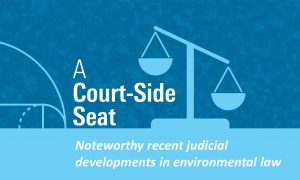The first quarter of 2022 has yielded a number of decisions, reversals and agency adjustments worth note.
FEDERAL CIRCUIT
U.S. Court of Appeals for the D.C. Circuit – Food & Water Watch v. Federal Energy Regulatory Commission
On March 11, 2022, the court decided the FERC case. On December 19, 2019, the Commission issued a Certificate to Tennessee Gas Pipeline and determined that a “modest expansion” and upgrade of the existing 11,000-mile natural gas pipeline would have no significant environmental impact. However, one of the Commissioners filed a partial dissent, arguing that the Commission’s treatment of the climate change impacts was inadequate. A petition for review was filed, and now the court has decided that the Commission erred in not accounting for the indirect effects of the expansion, namely the downstream emissions of greenhouse gas generated by the pipeline’s delivery of the gas to its customers. Consequently, NEPA’s requirement that a rigorous environmental assessment be made before the authorization was granted was violated. However, the court decided against vacating the Commission’s orders, which would have had a “disruptive effect” on the project which is, or soon will be, operational.
 Gravel2Gavel Construction & Real Estate Law Blog
Gravel2Gavel Construction & Real Estate Law Blog





